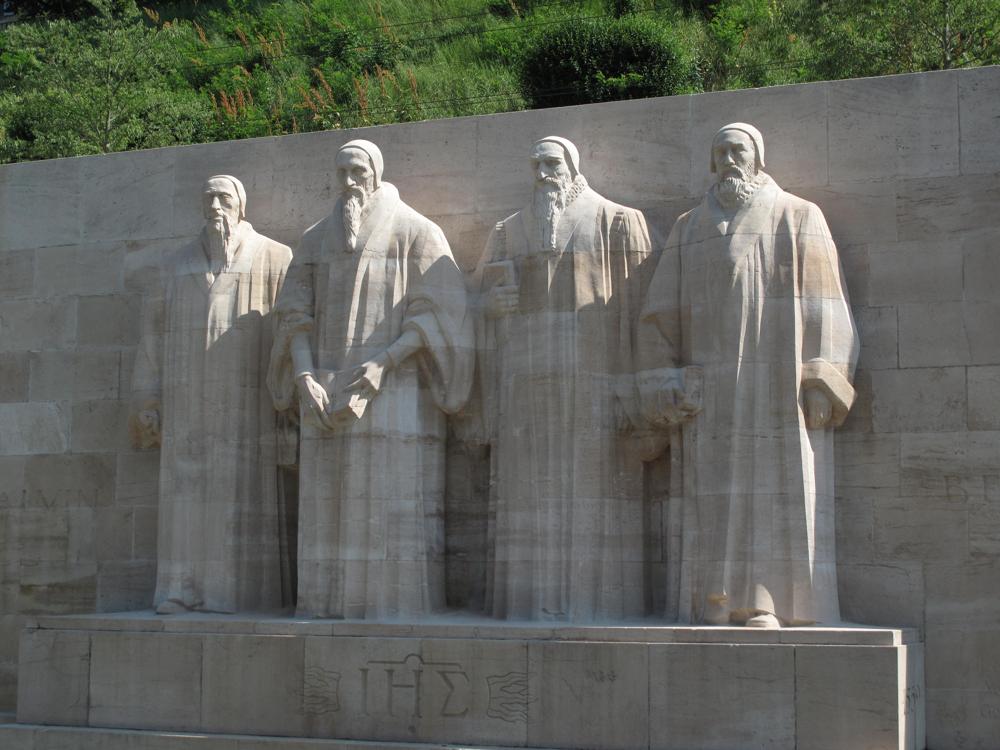A tour of the history of Geneva

The Reformation, the fête de l'escalade and the entry of Geneva into the Swiss Confederation are, among others, major episodes in the history of the city of Geneva.
The Reformation
When one mentions the Reformation, we always think of John Calvin for the Reformation in Geneva, Zwingli for the Reformation in Zurich and Martin Luther for the Reformation in Germany. Was Calvin really alone responsible for the Reformation in Geneva? Would the Reformation having took place in Geneva without Berne?
According to history, the Duke of Savoy wanted Geneva to be part of Savoy, but Geneva doesn't. Geneva allies itself with Fribourg and Bern in 1526. Guillaume Farel and Pierre Viret reform Neuchâtel in 1530 with the support of Berne. Berne want the reformers to be allowed to freely preach in Geneva and Farel went to Geneva. This is when the Bishop of Geneva leaves the town.
In 1535, the Catholic Mass is forbidden in Geneva. In 1536 , Lausanne and Geneva became Protestant. In Geneva, the Protestantism became the only permitted religion, those who want to remain Catholic had to leave the town. Geneva became a republic.
Subsequently, John Calvin was passing through Geneva and got retained by Farel. Farel wanted him to become the leader of the Protestant Church of Geneva. Calvin accepted and imposed very strict rules of conduct for the whole population : worship attendance is compulsory, dance and games are banned. Of course, he confronted himself with a strong opposition, but managed to impose its authority and thus created a new form of Protestantism, called Calvinism and Geneva became the Protestant Rome.
The Reformation Wall commemorates the Reformation and the Reformers Guillaume Farel , John Calvin , Theodore Beza (successor to Calvin ) and John Knox ( who has worked extensively with Calvin and reformed the Scottish Church ) .
The "Escalade" celebration in Geneva
During the night from the 11th to 12th of December 1602, the city of Geneva had been attacked by the Savoy. Geneva won the battle and is celebrating this victory every year on these dates. It is called "Fête de l'Escalade", and it is one of the major celebrations of the city of Geneva.
This celebration takes place throughout the whole city and in all families. The traditions are:
- The children dress up, knock on every door and sing two traditional songs "A la belle Escalade" and "Cé Qué lés no". By doing so, they primarily receive sweets, money or tangerines.
- Everyone eats the traditional soup of the Escalade, which is a soup made of finely chopped vegetables. This soup is also served in the old part of the city, between the city hall and the cathedrale, where the main parts of the celebration are held and include dressing up and dancing.
- The pot of the Escalade (marmite de l'Escalade) is broken> This is a pot made out of chocolate and filled with marzipan shaped into vegetables: two people hold hands and hit on it by saying "ainsi périrent les ennemis de la République", which means "this is how the enemies of the Republic perished".
But where does this tradition of the soup and of the chocolate pot come from? The "Mére Royaume" had prepared a vegetable soup for her family and did throw it on the soldiers as they came into town, thereby killing some of them and making other flee.
The entrance to Geneva in the Swiss Confederation
In 1798, Geneva is invaded and annexed to France. The city became the capital of a new department called Léman.
With its attachment to France, Geneva's economy goes through a period of deep recession and stagnation, especially the industries and banks. One of the changes introduced by joining France is the separation of civil and religious in a new civil code and a government headed by a mayor, two deputies and a municipal council.
Suffering economically, Geneva aspires to regain its independence. The French troops were driven out of the city by the Austrian army on the 31st of December 1813.
Geneva is, however, aware that isolation is no longer a viable option. It was then that Geneva, which had close ties with the Swiss Confederation for a long time, allies with them. To join into the Confederation, however, Geneva must meet two conditions: to open up from the French territory and present a constitution considered adequate for the Confederates. Twelve Savoyard towns and six cities of Gex are added to the canton of Geneva during the Congress of Vienna and Paris and Geneva thereby becomes contiguous to Switzerland. A new constitution was written in 1814. In 1815, Geneva entered the Swiss Confederation and became the 22nd Swiss canton .
The stones of Niton
These two rocks are located in Geneva harbor emerging from the water and dating from the last ice age. Some will say: "So, why are we talking about vulgar rocks?" Well voila, one of them was chosen to determine the altitude not only of Geneva but also for calculating all altitudes in Switzerland! It was General Guillaume-Henri Dufour have made that choice.
General Guillaume-Henri Dufour lived from 1787 to 1875, he was general, engineer, cartographer and Swiss politician. He is the author of the first map of Switzerland with precise topography, therefore named after him carte Dufour. But he was also co-founder of the International Red Cross.


